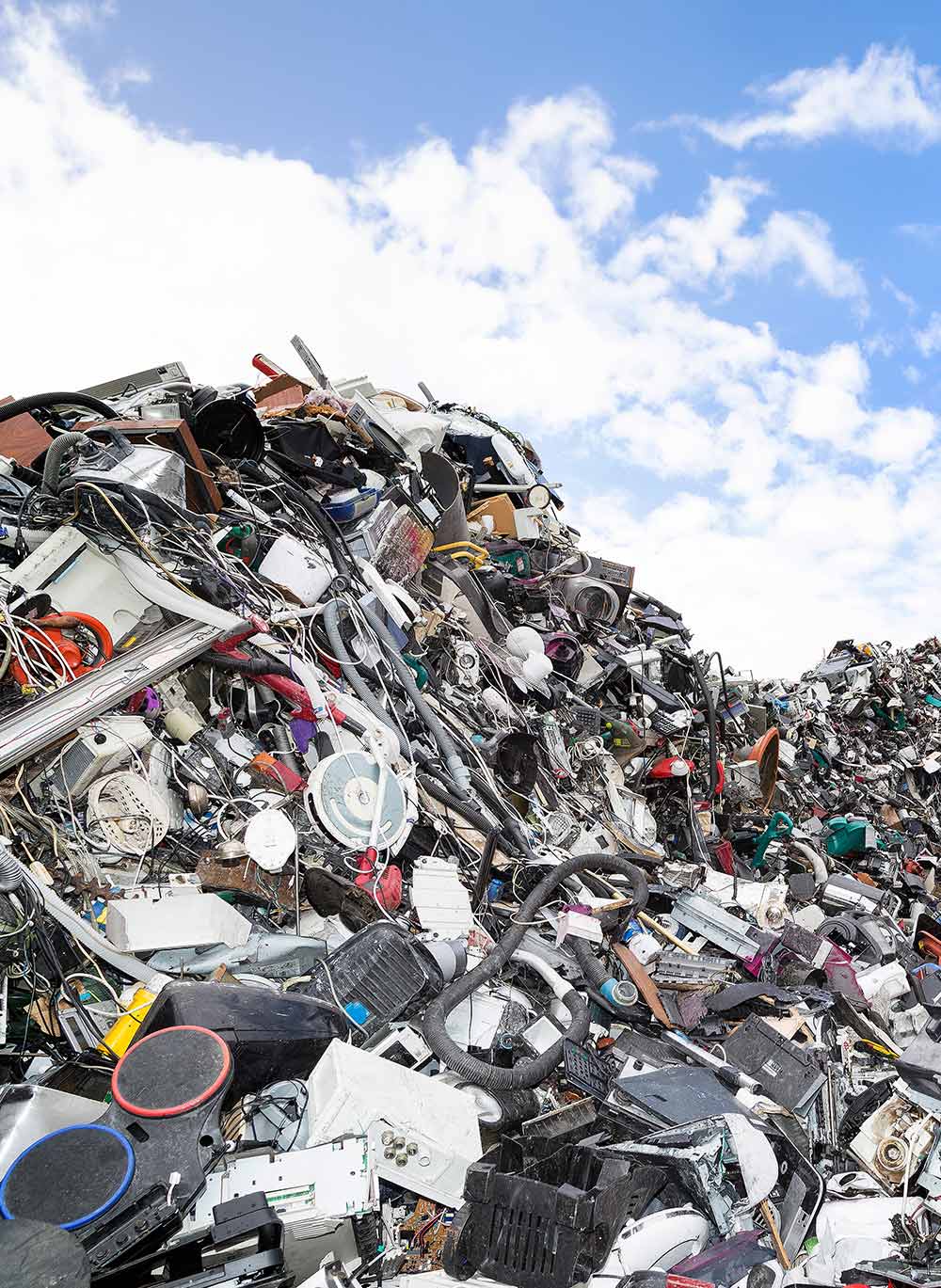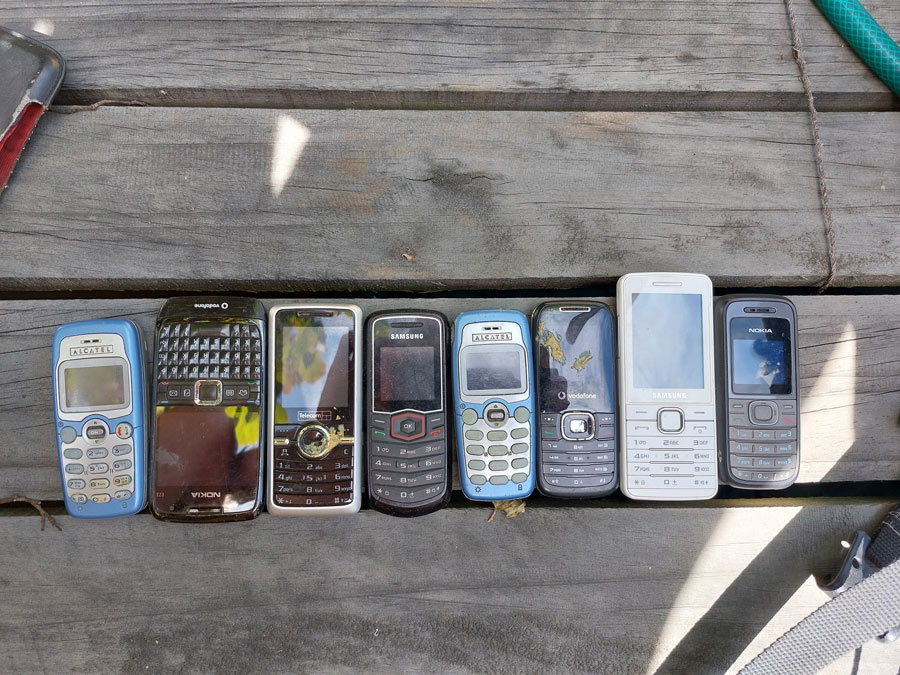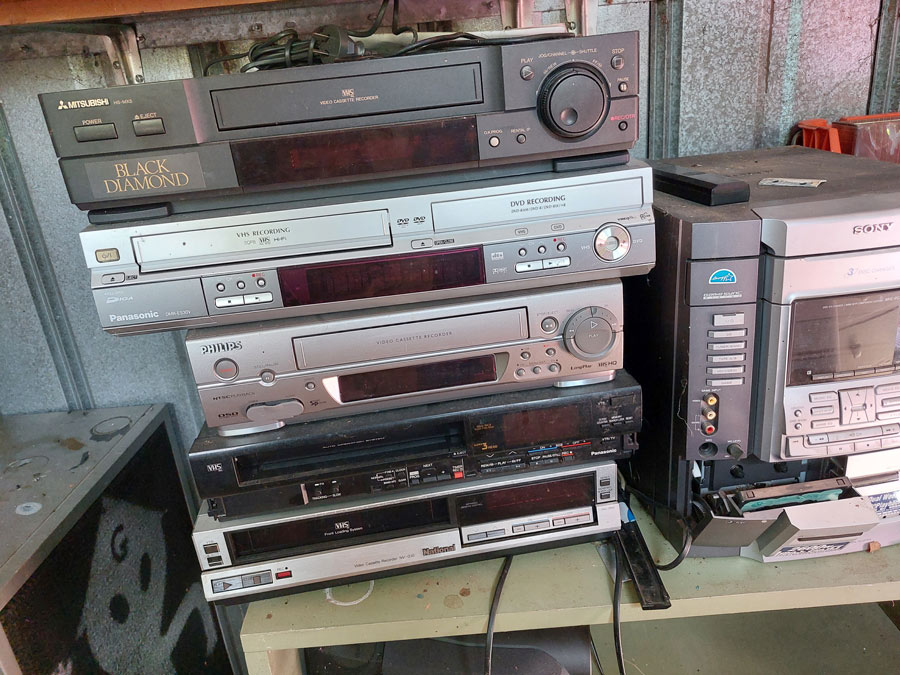

Our Tech Tipping Problem
Almost all of our electronics end up in landfill, and e-waste recycling is largely user-pays. What should happen to it and who should pay?
By George Driver
It was like a time capsule of appliances and electronics produced between 1979 and 2010. From the door of the shed I could see two VCRs, a slide projector, a guitar amplifier, a DVD player, two TVs, a computer monitor, a toaster, the components of at least three stereos, a lamp, a heater, a couple of fans and a popcorn maker. The rest of its contents were rendered completely inaccessible. The pile of discarded possessions had finally reached the door.
Over the next week, this burden was disgorged onto a nearby deck. Inside hidden boxes and drawers I discovered telephones, cellphones, computer modems, routers, a Sega Mega Drive II, dozens of power adapters and kilometres of electrical cable. At the back of the shed there was even a 40-year-old clothes drier that still worked — who knew? And all of it garnished with generous quantities of rat shit.
Happy holidays
These items, once valued and treasured, had expediently found their way into the shed over the decades in a property I share with my parents and brother. Usually this was after they suffered a minor fault or were rendered obsolete by the ravages of time. But they were put there with a sense of optimism: Perhaps one day I’ll fix that ever-present hiss on the Sony cassette player, or, even more bullishly, maybe someday there’ll be somewhere I can biff this stuff other than landfill.
In previous shed-clearing attempts, this is where I’d faltered. The appliances had been cleaned and organised before ultimately being restacked in the shed, waiting for better times — a cycle repeated every five years or so. I vowed this time would be different. Ignoring the beckoning call of the wheelie bin, I decided to finally find out where all of this junk should go.
Most people don’t bother. It’s estimated New Zealanders throw out almost 20kg of e-waste each year — stuff with plugs and batteries — amounting to nearly 100,000 tonnes. Some of these items can be particularly toxic, leaching heavy metals and other nasties into landfills, and potentially waterways, for decades or centuries.
And yet, at the moment, this is a rational response. The cheapest and easiest thing to do with all of this waste is to throw it in the bin. After a quick Google, I discovered that doing the right thing is both difficult and costly. I live in Clyde, Central Otago. The local resource recovery centre in Alexandra closed last year. The nearest is now an hour away in Wanaka. On its website I found a kind of shopping list detailing the charges for recycling my e-waste, potentially amounting to hundreds of dollars — $27 per LCD screen, $7 per router or modem, $5 per kilo of “miscellaneous”.
The call of the red bin became louder still.
In this darkest of moments, I began to dream of an alternative reality. A world where e-waste collection sites are plentiful and free. Where the services are funded not by under-pressure councils, but by the tech companies and appliance manufacturers that created this waste in the first place. And where maybe fees and regulations could incentivise these wealthy goliaths to make their products not only recyclable, but durable, repairable and refurbishable, so their path to my shed could be slowed, if not stopped entirely.
Missed opportunities
In 2005, Laurence Zwimpfer was faced with a problem. He had been working in the IT industry for more than three decades and at the time was the chair of the Computer Access New Zealand trust, which put refurbished computers into schools. One day he got a call from a school principal, telling him to take the now-ageing computers back.

Laurence Zwimpfer. Photo: Supplied.
“He said we don’t want these any more, come and take them,” Zwimpfer says. “That was a turning point for me. For the first time we started thinking about who’s responsible for this e-waste. That led to the realisation that we should actually be doing something about this.”
The issue wasn’t unique to the trust. Zwimpfer began investigating how a nationwide scheme for e-waste could work by making producers responsible for the waste they ultimately created.
The then-Labour government was also working on the issue. In 2005 it put out a discussion document asking for feedback on developing a stewardship scheme for electronic waste, as well as old cars, tyres, used oil and packaging.
Stewardship schemes work by making companies responsible for the lifecycle of the products they produce, including how they’re disposed of. This is usually achieved by putting a small fee on every item sold which goes towards collecting and recycling them at the end-of-life. By having higher fees on products that are more difficult to repair or recycle, this can also incentivise design changes to make products more sustainable and reduce waste.
The 2005 report noted stewardship schemes were already running in Europe, the United States, Canada, Japan and Australia, albeit often on a limited number of products. In New Zealand there were also a couple of voluntary schemes for phones, run by Vodafone (now One NZ), Telecom (now Spark), and one for whiteware run by Fisher and Paykel.
Around the same time, Zwimpfer and a colleague gained government funding to write a report on the country’s e-waste problem. In 2006, the pair estimated there were 16 million computers and TVs in the country, with a million more being imported each year. With no public recycling schemes operating, it was assumed almost all were going to landfill, potentially releasing toxic materials into the environment.
“This is a challenge and a threat that New Zealand cannot ignore,” they wrote.
The pair recommended a stewardship scheme for e-waste as a solution and found that, remarkably, the industry supported introducing a mandatory scheme. Producers didn’t want a voluntary scheme, because those that joined it would be at a competitive disadvantage. A mandatory scheme would level the playing field. The report warned that taking a voluntary approach “could be a ‘talkfest’ that drags on for years with no real resolution”
“We thought it could be operational by November 2006,” Zwimpfer says. “We thought six months was more than enough for the government to get their act together.”
In the meantime, Zwimpfer helped establish an event called “e-Day”, when people could drop off their electronic waste for recycling on one day each year. A pilot held in the carpark of Wellington’s Sky Stadium in 2006 hauled in 54 tonnes of e-waste.
Then change came out of a biscuit tin.
The biscuit tin bill
One of the quirks of New Zealand’s political system is the private members bill. It’s a kind of political lotto where each member of parliament can propose a law and enter it into a ballot, to be drawn from a biscuit tin bought from Deka in 1992.
The bills drawn from the tin are then debated and voted on, where they’re either rejected or go to select committee for further work and, potentially become law. It’s been called the most powerful biscuit tin in the country and has been the source of some of the country’s most dramatic law changes, including the legalisation of euthanasia, gay marriage, gay sex and prostitution.
In 2006, Green MP Nandor Tanczos’ Waste Minimisation Bill was pulled from the tin, which would enable the government to impose mandatory stewardship schemes on industries, as well as creating a levy on rubbish dumped at landfills.
It had a frosty reception from parties on the right. During the first reading, Nick Smith called it “PC rubbish that deserves to be thrown straight in the trash can”, while United Future MP Gordon Copeland called it “Soviet-style legislation”.
Nonetheless, it passed to select committee with support of Labour, the Maori Party and the Greens. Two years later, after much crossparty collaboration, it passed into law with near unanimous support. Only Act’s two MPs voted against it.
During its third and final reading, multiple National Party members were particularly enthusiastic about the potential for stewardship schemes to tackle waste. List MP Mark Blumsky said he was a “huge fan” of product stewardship and was even keen for a compulsory container deposit scheme to be included in the bill. Northland MP John Carter meanwhile looked forward to a future where all products were covered by stewardship schemes.
The government also began funding Zwimpfer’s e-Days around the country — 946 tonnes of e-waste was collected at 32 sites that October. At the same time, big tech companies were working with the government behind the scenes, actively advocating for a mandatory product stewardship scheme to be introduced.
The following month, the country went to the polls and everything changed.
Short circuit
In November 2008, a new National government was elected on a platform of cutting red-tape and taxes and stopping what it called “nanny state” interventions in the free market. The idea of charging the private sector for waste and potentially putting up the price of electronics was out of favour. Instead, as a government report later noted, “a voluntary product stewardship approach was encouraged”.
“The Nats came in and said ‘we think the industry should sort it out themselves’ and it never got off the ground,” Zwimpfer recalls.
Instead, some grants from the Waste Minimisation Fund — raised from the new landfill levies — went towards developing e-waste processing facilities. However, funding for e-Day was cut in 2011.
The government did invest $11.5 million in a free recycling programme to take back analogue TVs, which were being made redundant by the switch to digital TV. More than 222,000 TVs were recycled during the 18-month programme. After it ended, however, e-waste recycling was once again funded through grants for limited programmes and remained largely user pays.
Finally, in 2014 — six years after the waste legislation passed — the Ministry for the Environment began consulting on setting up compulsory stewardship schemes for e-waste, along with tyres, agriculture chemicals and farm plastics and refrigerant gases.
Submissions were overwhelmingly in favour of them, with only two per cent opposed. Most called for the government to act quicker and to go further — although the Telecommunications Forum New Zealand, representing the major telco companies, opposed a compulsory e-waste scheme.
The following year, however, the government commissioned a report to investigate a potential e-waste scheme and, surprisingly, the consultancy, SLR, found there was “insufficient data” to warrant a scheme. The report said the available information “does not satisfactorily prove that current management of e-waste in New Zealand causes signifi cant environmental harm and that significant benefits could be achieved through e-waste management under a regulated product stewardship scheme”. The stewardship scheme was canned.
“I think it was an absolute cop-out,” Zwimpfer says. “Both governments have dragged the chain with report after report.”
Despite industry also spending years developing a stewardship scheme for used tyres, this was also rebuffed by the government at the last minute in a move which reportedly left the industry “stunned”.
Back in 2006, Zwimpfer told people to store their old electronics in their sheds until a scheme was developed to recycle our e-waste. A decade on, the amount of electronics we consumed each year had skyrocketed, while their average lifespan had fallen.
The country’s sheds were getting full.
CTRL+ALT+DEL
Finally, more than a decade after the Waste Minimisation Act passed, momentum began to build.
In 2019, Green Party associate environment minister Eugenie Sage consulted on introducing compulsory stewardship schemes for e-waste, as well as agrichemicals, refrigerants, tyres, farm plastics and packaging.
By then there were 14 accredited voluntary schemes, but these only covered a tiny percentage of waste and half only applied to one company’s products. In the e-waste sector, this included the Re:mobile scheme for mobile phones, and schemes for Fuji Xerox products, Sharp products and a new pilot scheme for computers, phones and cameras. The amount recycled under these schemes amounted to less than 2 per cent of e-waste.
Again, the consultation found compulsory stewardship schemes were overwhelmingly popular, even with the industry. Of almost 4000 submissions, 93 per cent supported the proposals (although half were template submissions from Greenpeace and the Zero Waste Network). For e-waste, 96 per cent supported introducing a compulsory scheme, including 83 per cent of industry.
The country’s councils, who were paying for recycling services, were also near unanimous in support. In 2018, 96 per cent of Local Government New Zealand members called for a mandatory stewardship scheme for e-waste.
This time, however, the government followed through. In 2020, Sage declared e-waste, agrichemicals, refrigerants, tyres, farm plastics and plastic packaging as “priority products”, meaning mandatory stewardship schemes had to be developed within three years.
It was a landmark moment. Yet four years on, many of those who have been campaigning for a stewardship scheme for more than a decade have been left disappointed and disillusioned.
Buffering
“It’s been really frustrating,” says Sarah Pritchett.
Pritchett is the programme manager for WasteMINZ, which represents the country’s waste and recycling sector. She was part of a stakeholder group brought together to help develop recommendations for the e-waste stewardship scheme. But she and other stakeholders say the recommendations largely refl ected the will of the tech industry and retailers, rather than the public at large.

Sarah Pritchett. Photo: Supplied.
That was, in part, by design. The government proposed a “co-design approach” for the stewardship schemes, where they would be developed with industry. “Reasons for this include that government intervention can be slow and business can be far more agile in leading innovation in areas of expertise,” the consultation document said.
In the event, however, the industry has been in the driver’s seat. The scheme’s design has been led by a not-for-profit called TechCollect, which is owned by a tech-industry body called the Australia and New Zealand Recycling Platform (ANZRP). Its members include some of the biggest names in tech and retail, including Apple, Microsoft, Dell, HP, Canon and the Warehouse Group.
TechCollect launched a voluntary stewardship scheme in New Zealand in 2018, under which people could drop off unwanted phones, computers and cameras for free at OfficeMax stores around the country. The scheme’s members then pay an Auckland company to recycle them — it claims 98 per cent of the materials are recycled. In 2019, it received a $320,000 grant from the Waste Minimisation Fund to develop rules for a compulsory scheme and to expand its own scheme (it now collects e-waste at 39 locations — mostly Noel Leeming and Warehouse Stationary stores — and has recycled 345,000 tonnes of material). When the priority-products designation was announced in 2020, TechCollect was given the task of leading the design process.
For the first time, this would create a nationwide network of e-waste collection sites, funded by producers rather than taxpayers and ratepayers, and cover the recovery of the precious metals, toxic materials and plastics contained in electronics.
This process raised the hackles of many waste minimisation groups, as there was no opportunity for an independent body to step forward and develop the scheme, and many were left feeling blindsided.
“It’s not a very transparent process,” Pritchett says. “Because it was through a grant application it’s all done behind closed doors and no one else could put their hand up to run the scheme.”
After a three-year process, which involved a stakeholder group representing zero-waste groups, recycling groups, councils and industry, TechCollect released recommendations in June last year. It proposed adding a fee to all electrical products — defined as anything with a battery or plug — to cover the collection and recycling of e-waste in the country, including the “legacy” e-waste stashed in people’s sheds.
For the first time, this would create a nationwide network of e-waste collection sites, funded by producers rather than taxpayers and ratepayers, and cover the recovery of the precious metals, toxic materials and plastics contained in electronics.
However, Pritchett and other stakeholders say there is little emphasis on efforts to reduce waste in the first place. “A lot of us were very passionate about it being focused on repair, refurbishment and re-use before recycling, because you maintain the value of the product if it’s reused and repaired. It felt like what we were saying wasn’t reflected in what came out. There’s nothing beyond the usual incentives to do that.”
Consumer New Zealand head of testing Paul Smith was also on the stakeholder group and agrees the outcome was watered down. “There was very much a sense that a lot of the industry wanted the stewardship scheme to be the minimum viable product.” It ended up in a reasonable place but it could have been a lot better.
“This is the crux of the problem,” he says. “The industry is set up to sell more and the recycling industry is set up to recycle all that stuff. So as a closed system more volume is advantageous to them. And that’s the thing we’ve got to break, so I don’t think having an industry led scheme is going to work.”
The short-term focus recommended by TechCollect is “to strengthen and expand the existing recovery and recycling network”. Repair and reuse is listed as a secondary focus that will only be addressed in the “medium term”. The recommendations say it will promote repair and reuse of electronics, rather than actually incentivise it.
TechCollect’s website states that the scheme’s focus would shift to re-use and repair once “suitably qualified repair agents are widely available”
Some wanted to see higher fees for products that were less recyclable, repairable or refurbishable, what’s referred to as “ecomodulation”. This should incentivise design changes to reduce the stream of waste. However, the recommendations only say this is a “possible approach” in the long-term and must be subject to further consultation with the industry.
The risks of an industry-led process were flagged by others. In a paper titled “Foxes Guarding the Hen House?”, zero-waste campaigner and academic Hannah Blumhardt says “industry-led co-design allocates power to those with a vested interest in the status quo linear economy, while effectively marginalising other interest groups and experts”.
She asks whether we can really expect “the electronics industry, which profits from product upgrades and obsolescence, to recommend regulations that require longer-lasting, repairable products or increased sharing or service-based business models?”
It’s worth noting that the ANZRP is explicit that it exists to advocate “for the interests and needs of its members”, which include some of the world’s biggest tech companies.
TechCollect head of operations Michael Dudley rejects these criticisms, however, pointing out that the scheme is required to focus on interventions at the highest point in the waste hierarchy “wherever possible” — waste-speak for prioritising re-use, repair and refurbishment over recycling.
When asked whether there was a conflict of interest in the industry designing the scheme, when companies are incentivised to sell as many products as possible and sometimes profit by shortening the lifespan of products, Dudley says that’s a “fair statement”. But he says it does not apply in the New Zealand context, because of the government expectations for the scheme.
“If you look at our recommendations, it’s not the lowest cost approach,” Dudley says. “It is ambitious and seeks to tackle the entire waste hierarchy. While I’d agree that your characterisation of offshore markets is accurate, I don’t think it’s the same here.”
“Can we really expect… the electronics industry, which profits from product upgrades and obsolescence, to recommend regulations that require longer-lasting, repairable products or increased sharing or service- based business models?”
Laurence Zwimpfer, also a stakeholder, is just relieved to have some concrete steps taken to address the e-waste issue.
“It’s a start and I’m very happy to get some regulations on the table. It’s a more robust attempt at dealing with the problem that looks at the whole e-waste scene — not just computers and TVs, but all electronic devices. But we’ve got to make sure it’s not the end and it keeps progressing. I just hope they get on with it.”
A right to repair?
As I open yet another window on the web browser on my Macbook, the rainbow wheel appears again and the device is transformed from being a portal to the world and the foundation of my livelihood, to a small and inefficient fan heater.
I search “can I upgrade the RAM on my Macbook?”. The answer: No. The small, relatively cheap computer chips that determine the speed of my laptop have been soldered onto the motherboard, making an upgrade costly and difficult. If I could replace this component myself with a plug-in chip, I could double the RAM and extend the laptop’s life considerably for about $83. Nor am I able to expand the storage on this Macbook. Despite the fact that a 512 gigabyte micro SD card that’s the size of my pinky fingernail could triple its storage capacity for just $68, this component is also inaccessible and soldered on, limiting any upgrade. Instead, in a couple of years, this laptop will probably end up in the shed, with my last Macbook, waiting for a stewardship scheme to get off the ground.
It’s one of the most infuriating features of modern life. The products that we have come to depend on are often purposefully designed to make fixing or upgrading them nigh on impossible. Even when it is possible to upgrade a device, some manufacturers have used software to prevent them from working properly if they’re repaired using recycled or thirdparty parts, or repaired by independent technicians.
In 2019, Apple even sued a Norwegian phone repair shop owner, claiming the replacement screens he was using to fix iPhones were counterfeit. The repairer claimed he was using refurbished parts.
It all makes repair and refurbishment often prohibitively expensive when compared to buying a new device. As a result, many electronics which could be fixable and have valuable components become “bricked”, having the same utility as a block of fired clay.
Even products that are covered by a warranty are often biffed when they are returned to the retailer or manufacturer. In 2022, Consumer bought six new food mixers and put a tracking device in them and unsoldered a single wire — an easy fix. When they returned the items they found half the items were sent straight to landfill, while one was recycled (a $740 Kenwood mixer from Farmers), one had useful parts removed and was recycled, and only one was repaired and sold as refurbished.
It’s the other side of our e-waste problem. How do we reduce the volume of waste by making products last longer and be easily repairable and upgradable?
It’s a problem University of Auckland law professor Alex Sims has been working to address. In a paper published last year with Massey University lecturer Trish O’Sullivan, the pair put it simply: Goods are being intentionally designed not to last and to be difficult to repair so that they’re thrown away and consumers buy more. When items can be repaired, many manufacturers are attempting to monopolise the process, controlling the supply of parts, tools, manuals and software locks to prevent third-party repairs.

Alex Sims. Photo: Supplied.
“The dominant business model incentivises planned obsolescence and deliberately making goods difficult to repair.”
A lot of these issues are enabled through our laws. The Copyright Act can be used to prevent the importation of third-party parts and control the dissemination of repair manuals.
To stop this, Sims is advocating for a new Right to Repair Act, requiring durability and repairability labelling and parts to be available for items sold for a fixed period.
Other countries are introducing similar right-torepair legislation. The UK introduced regulations in 2021, requiring products to be able to be repaired by readily available tools, to prevent the use of things like proprietary screws to make repairs difficult. The regulations also require parts to be available for seven to 10 years after production has ceased.
The European Union is developing legislation requiring particular products to be repairable and that spare parts are available for minimum periods, while states in the US have introduced similar legislation. France, meanwhile, has introduced a durability and repairability rating system, so consumers can make informed choices.

Piles of tech junk in George’s shed await a cost effective and convenient e-waste recycling scheme. Photo: George Driver

None of this has been picked up in New Zealand yet. “We are so far behind,” Sims says. But that has one advantage — there are many examples that we can copy and learn from.
On the flipside, Sims says if New Zealand remains unregulated it could potentially become a dumping ground for products which are prohibited in other countries due to being difficult to repair or nondurable.
It’s no simple fix. There would need to be changes to five other pieces of legislation, involving multiple different ministries. Even then, you need wellfunded institutions that can investigate breaches of these laws and enforce them.
“There’s not one silver bullet,” Sims says. “We have lots of laws but they’re breached all the time and not enforced.”
Consumer New Zealand has also been petitioning the government to introduce repairability and durability ratings and a right to repair, although so far it’s had a lukewarm reception from the government.
“The response we’ve had from the government is that ‘we can see this is the sort of thing that we want to do’ and there’s an ambition there, but no real desire to push forward with it,” says Paul Smith.
Some tech companies are taking proactive steps. A Dutch company has made the ‘Fairphone’, which allows consumers to replace most of the components themselves at relatively low cost, including the screen, cameras, battery and USB-C port. A US company, Framework, has developed a fully modular laptop, where all of the components can be easily replaced and upgraded. Neither product is yet available in New Zealand.
Page not found
The previous government was taking some small steps towards introducing right-to-repair legislation. It consulted on introducing new waste legislation in 2021, saying it was “interested in expanding the legal requirements for the right to repair”, by introducing similar legislation to Europe and the UK. Eighty-five per cent of submissions supported the proposal.
The document also proposed tightening up the stewardship scheme laws to require schemes to go beyond recycling and requiring them to be independently assessed. It would also have enabled ministers to require improvements to schemes and give them more enforcement powers.
The Ministry for the Environment’s website said it aimed to introduce new legislation either late this year, or early next year, and to enact the legislation in 2025. However, following the election of the National-led coalition, the website was updated in March and reference to new legislation has been removed.
It’s not yet clear what direction the Luxon government will take on these issues — or whether the new legislation has been ditched. In a statement, a spokesperson for the ministry said: “The minister is currently receiving advice on the waste and resource efficiency work programme and will be considering that advice and establishing priorities over the coming months.”
Meanwhile, progress on the e-waste stewardship scheme has also stalled. A spokesperson for environment minister Penny Simmonds said “subject to Cabinet approval, consultation on proposed regulations would take place in 2025.” The minister did not respond to requests for an interview or written questions on whether new waste legislation would be going ahead.
Other stewardship schemes have been progressing, however. In March, a compulsory stewardship scheme for tyres finally got underway. A $6.65 fee has now been placed on all car tyres, which will fund a free recycling programme from September this year. A large proportion of the tyres will be burned in Golden Bay Cement’s kilns, displacing coal, while some will be used to make new products from granulated rubber.
Like e-waste, schemes for EV batteries, farm plastics and refrigerants are also in a limbo, awaiting cabinet approval and consultation.
A quiet defeat
It’s now been almost three months since I started to empty the shed. Some of the old electronics could be dropped off at Noel Leeming in Queenstown and recycled through TechCollect’s programme. But a lot of it has gone back into the shed once more.
Hopefully, when the boxes of junk inevitably reach the shed’s door once more, it’ll be a short drive to recycle them in a scheme funded by some of the most powerful companies in the world. And maybe, one day, the flow of electronics to the shed will stop entirely.


